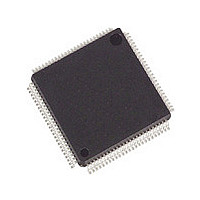ADSP-2186KST-133 Analog Devices Inc, ADSP-2186KST-133 Datasheet - Page 6

ADSP-2186KST-133
Manufacturer Part Number
ADSP-2186KST-133
Description
IC DSP CONTROLLER 16BIT 100LQFP
Manufacturer
Analog Devices Inc
Series
ADSP-21xxr
Type
Fixed Pointr
Datasheet
1.ADSP-2186BSTZ-160.pdf
(36 pages)
Specifications of ADSP-2186KST-133
Rohs Status
RoHS non-compliant
Interface
Host Interface, Serial Port
Clock Rate
33.3MHz
Non-volatile Memory
External
On-chip Ram
40kB
Voltage - I/o
5.00V
Voltage - Core
5.00V
Operating Temperature
0°C ~ 70°C
Mounting Type
Surface Mount
Package / Case
100-LQFP
Device Core Size
16b
Architecture
Enhanced Harvard
Format
Fixed Point
Clock Freq (max)
33.3MHz
Mips
33.3
Device Input Clock Speed
33.3MHz
Ram Size
40KB
Operating Supply Voltage (typ)
5V
Operating Supply Voltage (min)
4.5V
Operating Supply Voltage (max)
5.5V
Operating Temp Range
0C to 70C
Operating Temperature Classification
Commercial
Mounting
Surface Mount
Pin Count
100
Package Type
LQFP
Lead Free Status / Rohs Status
Not Compliant
Available stocks
Company
Part Number
Manufacturer
Quantity
Price
Company:
Part Number:
ADSP-2186KST-133
Manufacturer:
AD
Quantity:
18
Company:
Part Number:
ADSP-2186KST-133
Manufacturer:
AD
Quantity:
5 510
Part Number:
ADSP-2186KST-133
Manufacturer:
ADI/亚德诺
Quantity:
20 000
ADSP-2186
Interrupt routines can either be nested, with higher priority
interrupts taking precedence, or processed sequentially. Inter-
rupts can be masked or unmasked with the IMASK register.
Individual interrupt requests are logically ANDed with the bits
in IMASK; the highest priority unmasked interrupt is then
selected. The power-down interrupt is nonmaskable.
The ADSP-2186 masks all interrupts for one instruction cycle
following the execution of an instruction that modifies the
IMASK register. This does not affect serial port autobuffering
or DMA transfers.
The interrupt control register, ICNTL, controls interrupt nest-
ing and defines the IRQ0, IRQ1 and IRQ2 external interrupts to
be either edge- or level-sensitive. The IRQE pin is an external
edge-sensitive interrupt and can be forced and cleared. The
IRQL0 and IRQL1 pins are external level-sensitive interrupts.
The IFC register is a write-only register used to force and clear
interrupts.
On-chip stacks preserve the processor status and are automati-
cally maintained during interrupt handling. The stacks are twelve
levels deep to allow interrupt, loop and subroutine nesting.
The following instructions allow global enable or disable servic-
ing of the interrupts (including power-down), regardless of the
state of IMASK. Disabling the interrupts does not affect serial
port autobuffering or DMA.
ENA INTS;
DIS INTS;
When the processor is reset, interrupt servicing is enabled.
LOW POWER OPERATION
The ADSP-2186 has three low power modes that significantly
reduce the power dissipation when the device operates under
standby conditions. These modes are:
• Power-Down
• Idle
• Slow Idle
The CLKOUT pin may also be disabled to reduce external
power dissipation.
Power-Down
The ADSP-2186 processor has a low power feature that lets the
processor enter a very low power dormant state through hard-
ware or software control. Following is a brief list of power-down
features. Refer to the ADSP-218x DSP Hardware Reference,
“System Interface” chapter, for detailed information about the
power-down feature.
• Quick recovery from power-down. The processor begins
• Support for an externally generated TTL or CMOS proces-
executing instructions in as few as 200 CLKIN cycles.
sor clock. The external clock can continue running during
power-down without affecting the lowest power rating and
200 CLKIN cycle recovery.
• Support for crystal operation includes disabling the oscillator
• Power-down is initiated by either the power-down pin (PWD)
• Interrupt support allows an unlimited number of instructions
• Context clear/save control allows the processor to continue
• The RESET pin also can be used to terminate power-down.
• Power-down acknowledge pin indicates when the processor
Idle
When the ADSP-2186 is in the Idle Mode, the processor waits
indefinitely in a low power state until an interrupt occurs. When
an unmasked interrupt occurs, it is serviced; execution then
continues with the instruction following the IDLE instruction.
In Idle mode IDMA, BDMA and autobuffer cycle steals still
occur.
Slow Idle
The IDLE instruction is enhanced on the ADSP-2186 to let the
processor’s internal clock signal be slowed, further reducing
power consumption. The reduced clock frequency, a pro-
grammable fraction of the normal clock rate, is specified by a
selectable divisor given in the IDLE instruction. The format of
the instruction is
IDLE (n);
where n = 16, 32, 64 or 128. This instruction keeps the proces-
sor fully functional, but operating at the slower clock rate. While
it is in this state, the processor’s other internal clock signals,
such as SCLK, CLKOUT and timer clock, are reduced by the
same ratio. The default form of the instruction, when no clock
divisor is given, is the standard IDLE instruction.
When the IDLE (n) instruction is used, it effectively slows down
the processor’s internal clock and thus its response time to
incoming interrupts. The one-cycle response time of the stan-
dard idle state is increased by n, the clock divisor. When an
enabled interrupt is received, the ADSP-2186 will remain in the
idle state for up to a maximum of n processor cycles (n = 16, 32,
64, or 128) before resuming normal operation.
When the IDLE (n) instruction is used in systems that have an
externally generated serial clock (SCLK), the serial clock rate
may be faster than the processor’s reduced internal clock rate.
Under these conditions, interrupts must not be generated at a
faster rate than can be serviced, due to the additional time the
processor takes to come out of the idle state (a maximum of n
processor cycles).
to save power (the processor automatically waits approxi-
mately 4096 CLKIN cycles for the crystal oscillator to start
or stabilize), and letting the oscillator run to allow 200 CLKIN
cycle start-up.
or the software power-down force bit.
to be executed before optionally powering down. The
power-down interrupt also can be used as a nonmaskable,
edge- sensitive interrupt.
where it left off or start with a clean context when leaving the
power-down state.
has entered power-down.













